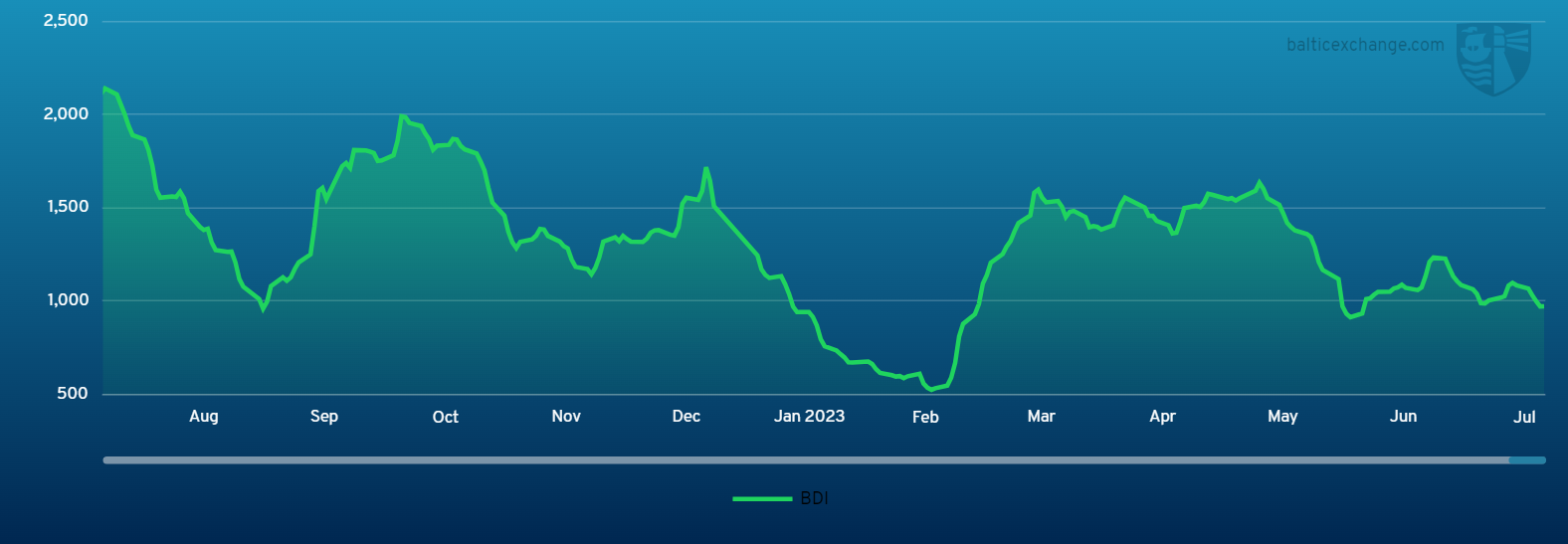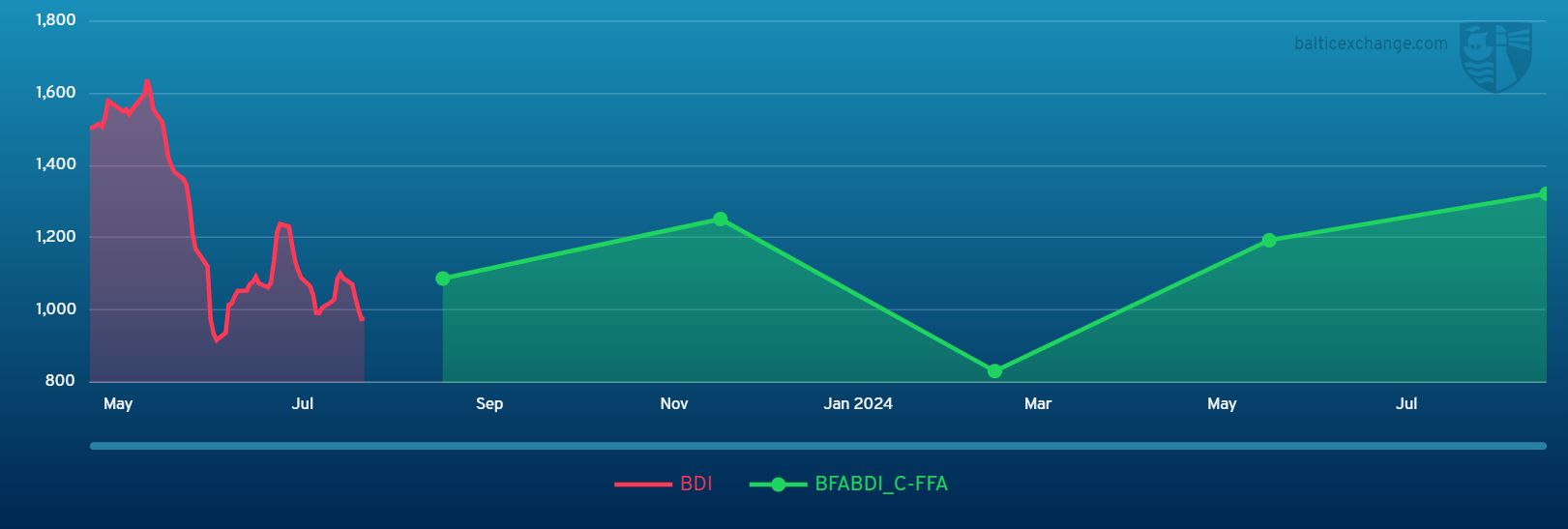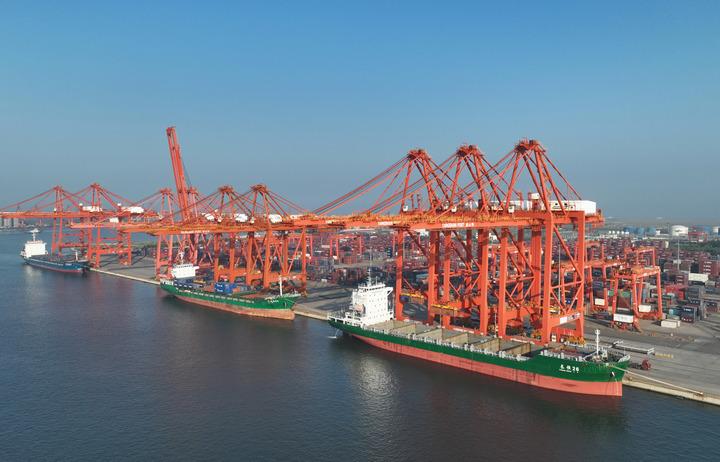BEIJING, July 24 (Xinhua) -- The Baltic Exchange has published its weekly report of the dry and tanker markets for July 17-21, 2023 as below:
Capesize
The Pacific market this week was marked by overall sluggishness, experiencing limited activity. The presence of two out of the three major players failed to stimulate trading volumes, leading to stagnant and lacklustre market conditions. Rates in the Pacific have continuously declined throughout the week, reflecting the subdued demand and limited fixture activity. Today’s market activity has shown a slight correction in rates, with a few fixtures concluding at slightly improved levels.
In contrast to the Pacific, the Atlantic market has experienced a slightly higher level of activity, primarily driven by the South Brazil and West Africa routes to the Far East. However, despite this modest increase in activity, the market faced difficulties in gaining momentum or making any significant progress. Throughout the week, freight rates have come under pressure, although, as the week comes to an end, brokers have observed signs indicating that the market is gradually stabilising, suggesting that it may be beginning to establish a more balanced level and a notable clear out of tonnage.
Panamax
The Panamax market provided further losses this week and is showing little signs of abating. Despite a steady level of activity, this failed to stem the tide with both basins yielding sizeable losses. The Atlantic saw rates erode for a further successive week, as pressure from the nearby and committed ships continued to underpin the market. From East Coast South America, the focus this week was on mid-August arrival with the APS load port rates now hovering around the $14,000 + $400,000 mark, but limited support to end the week. Asia similarly witnessed another week of falls. A lack of demand on the longer round trips remained the nemesis to an already weak market. There were reports midweek of an 82,000dwt delivery Japan achieving $8,750 for an Australian round trip, but activity remained light as the market drifted. Like previous weeks, older and smaller units tended to soak up much of the Indonesia coal demand.
Ultramax/Supramax
A mixed week for the sector with the Asian arena leading the way. The Atlantic generally remained positional throughout, with the US Gulf being the only relatively stable region despite slightly lower levels of enquiry as the week progressed. From Asia, the demand for Indonesian coal remained, which helped rate levels to remain fairly reasonable. However, a lack of support from the NoPac kept rates in check and readily available tonnage. In the Atlantic, a 52,000dwt was heard to have been fixed for a trip to EC Mexico at $12,500. Elsewhere a 54,000dwt fixed a trip from Spain to Morocco with grains at $9,500. From Asia, a 56,000dwt open Indonesia fixed a trip to China in the mid $10,000s. Further north, a 55,000dwt fixed from North China to SE Asia at $5,000. Elsewhere, a 55,000dwt fixed a trip delivery Bin Qasim redelivery Madagascar at $6,750 for the first 33 days and $10,750 thereafter.
Handysize
With summer fully underway, it was a week of limited activity across both basins. In the South Atlantic, whilst prompt activity was said to have remained restrained, there was optimism that August would bring some positivity to the region as levels of enquiry were said to improve. A 39,000dwt was fixed from Santos to Morocco at $11,500 and a 37,000dwt fixed from Rio Grande to Venezuela with an intended cargo of paddy rice at $13,500. Meanwhile a 40,000dwt fixed from San Lorenzo to Santos at $8,500. On the Continent a 36,000dwt fixed from Rostock to the US Gulf with an intended cargo of grains at $5,000 and a 34,000dwt fixed from Grenaa to Icdas with an intended cargo of scrap at $5,250. In Asia, a 38,000dwt was fixed from Geelong via Western Australia to China with an intended cargo of grains in the high $8,000s whilst a 38,000dwt was fixed from Kuantan via Indonesia to China’s Taiwan at $6,300.
Clean
LR2
MEG LR2’s have been tested down this week off the back of an abundance of available tonnage. Subsequently TC1 again dropped below WS100, dipping 11.67 points to WS88.61. TC20 has similarly come off $81,250 to $2,775,000.
West of Suez, Mediterranean/East LR2’s suffered another week of inactivity. The TC15 index has held at just under the $2,300,000 mark and, with the TCE in the negative, freight looks to have reached a floor.
LR1
In the MEG, LR1’s managed to hold onto freight levels better than their larger siblings this week. TC5 dropped 10 points to WS101.25 and TC8 lost in incremental $14,300 to $2,421,250.
On the UK-Continent, TC16 was again pressured down from little open market demand. The index lost 10.62 points to WS110.94.
MR
MEG MR’s recovered for the second week-on-week. The TC17 index ticked up 11.78 points to WS206.07 at the time of writing. This also takes the TCE back over the $20,000/day Baltic TCE round trip.
UK-Continent MR’s resurged this week, with a consistent influx of cargoes cemented in a bullish sentiment from early on in the week. TC2 accumulated 40.75 points, taking the index up too WS155.25 with the Baltic vessel TCE improving 135pct to $15,195/day round trip. TC19 similarly hopped up 39.37 points to WS166.25.
USG MR’s followed their new characteristic of notably steep freight climbs in busy periods. TC14 shot up from WS110 to WS163 early in the week, only to resettle at WS153.33 at the time of writing. A run the Caribbean and TC21 rocketed up from $720,000 to $941,000 to the return back to $854,000.
The MR Atlantic Triangulation Basket TCE saw an 85pct improvement from $16,379 to $30,053.
Handymax
In the Mediterranean, rates held level around the WS170 mark. Up on the UK-Continent, TC23 rocketed up 32.5 points to WS169.17.
VLCC
The market weakened slightly this week. In the Middle East, while the market has been a little quiet on the face of it, ships have been fixed under the radar, adding to the cargo count. The feeling is that early August stems are almost covered, which provides for a softer sentiment. The rate for 270,000 mt Middle East Gulf to China yesterday was assessed at WS52.42, a week-on-week drop of a single point, which shows a daily round-trip TCE of $31,200 basis based on the Baltic Exchange’s vessel description. The 280,000 mt Middle East Gulf to US Gulf trip (via the cape/cape routing) is also rated one point lower than a week ago at WS32.61.
In the Atlantic market, a similar situation prevailed, with the market being perceivably quiet and oil company relets seem to be the favourable candidates, whilst independent owners hold back as much as possible in order to resist a rate drop, leaving sentiment flat. For the 260,000 mt West Africa/China trip the rate is 0.5 point up on last week at WS53.10, which shows a round voyage TCE of $33,000 per day, about $1,500 more than last Friday. The rate for 270,000 mt US Gulf/China has firmed though and is now $344,445 more than last Friday at $7,805,556 (about $31,300 per day round trip TCE).
Suezmax
Suezmaxes in West Africa have had a torrid week, with rates marching downwards and despite a five-point reset on Wednesday for West Africa to Europe, the market has since been quiet which suggests the floor has not yet been reached. For 130,000 mt Nigeria/Rotterdam, rates have lost 18.5 points over the week at WS84.55 (a daily round-trip TCE of $27,700). In the Middle East, the rate for 140,000 mt Basrah/Lavera remains flat around the WS56-57 mark.
Aframax
In the North Sea, the rate for the 80,000 mt Hound Point/Wilhelmshaven remained steady around the WS132.5-135 level (showing a round-trip daily TCE of $37,800, about $1,700 more than last Friday). In the Mediterranean, with increased tensions in the Black Sea, some of the traditional Black Sea export vessels have been fixing short cross-Med cargoes, which begs the question if that is their future business as well, thereby increasing the pool of available vessels and weakening sentiment. The rate for 80,000mt Ceyhan/Lavera lost three points over the week to WS121.17 (a daily round trip TCE of $26,200).
Across the Atlantic, in the Stateside Aframax market, the rollercoaster ride continues, with the rate for 70,000mt East Coast Mexico/US Gulf peaking at WS195 and now beginning to drop back. Week-on-week the rate has risen about 16 points to WS189.38 (which shows a TCE of about $52,700/day round trip) and for 70,000mt Covenas/US Gulf the rate is 13 points higher than last Friday at WS173.13 (a round-trip TCE of $43,100/day). Conversely, the rate for the trans-Atlantic route of 70,000 mt US Gulf/Rotterdam has dropped about seven points since last Friday to WS173.13 (a round trip TCE of close to $43,200/day).
LNG
There is no new tail to spin with LNG this week. The index has remained flat for all three routes, shifting marginally due to an increase in fuel prices but with little to no interest in spot enquiry sentiment has remained flat. Focus for spot is muted while market players weigh up options for the upcoming winter market. Rates at these levels have seen various ships taken off market and back into charterers hands to help prepare for what everyone hopes will be another rollercoaster ride in the winter.
The index itself moved positively and Aus-Japan BLNG1g gained a little over the week to close at $68,886, a rise of $1,351. The Atlantic market saw more activity intra basin, which some brokers suggested could push US-Japan rates higher. Indeed BLNG3g saw the greatest gain on the week of $5,730 to close at $88,087, while traditionally the busiest route BLNG2g into the UK was extremely flat moving $583 to finish at $70,293. Despite interest in period still occupying much of the discussion around the table rates did fall for six-month, one-year, and three-year terms. There was a report a ship was fixed for period with one of the main factors being that it was sublet back out into the market.
LPG
There has been quite a split of opinion on the LPG this week, especially in the Middle East. The BLPG1 run for Ras Tanura-Chiba fell by $4.413 overall but brokers said that the market was heading in both directions at once. Tonnage was tight on the front end, especially with those ships traditionally seen as being ‘cheaper’, but there was little enquiry as well, so rates held. While looking further out to August, there were more ships coming into play but levels of enquiry were lower at time of writing. This has kept the market relatively muted and the week closed at $107.286, which gives a daily TCE Earning of $95,599.
The US market was on calmer waters, still losing a few dollars overall but holding steady considering we are in the summer months. There were few questions asked going into Flushing while the US-Chiba had steadier interest rates did not hold up. On BLPG2 Houston-Flushing, a fall of $1.6 meant we closed at $100.8, while the eastern run BLPG3 Houston-Chiba fell by $2.5 and closed at $172.357 giving a daily TCE earning of $96,741.
Headquartered in London and a subsidiary of the Singapore Exchange (SGX), the Baltic Exchange publishes a range of indices and assessments which provide an accurate and independent benchmark of the cost of transporting commodities and goods by sea. These include the Baltic Dry Index (BDI), the dry bulk shipping industry's best known indicator. Published daily since 1985, this provides a snapshot of the daily spot market earnings of capesize, panamax and supramax vessel types on the world's key trading routes.

Chart shows Baltic Dry Index (BDI) during July 21, 2022 to July 21, 2023

Baltic Forward Assessment for BDI
In March 2018 the BDI was re-weighted and is published using the following ratios of time charter assessments: 40 percent capesize, 30 percent panamax and 30 percent supramax. The information is provided by a panel of international shipbrokers.
(Source: The Baltic Exchange, edited by Niu Huizhe with Xinhua Silk Road, niuhuizhe@xinhua.org)




 A single purchase
A single purchase









